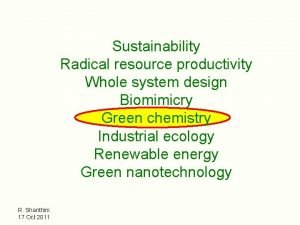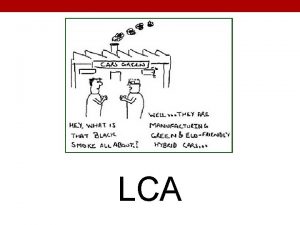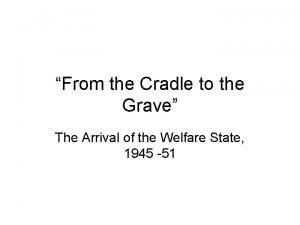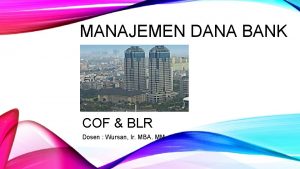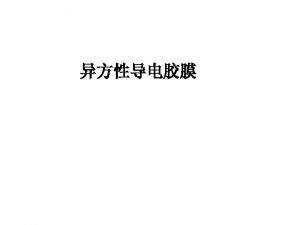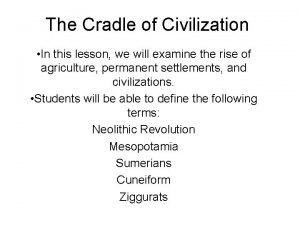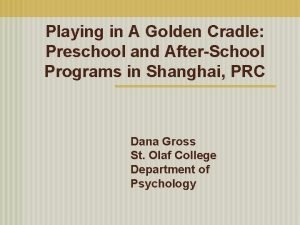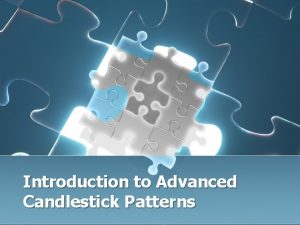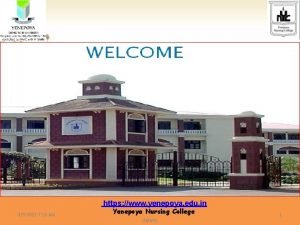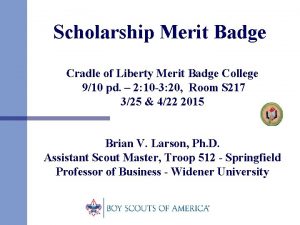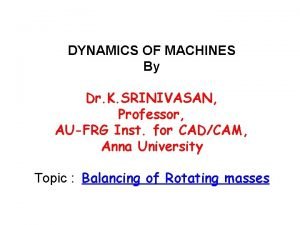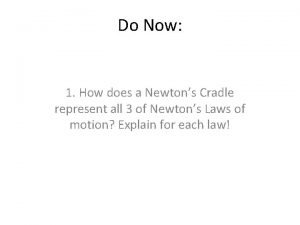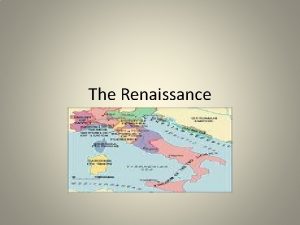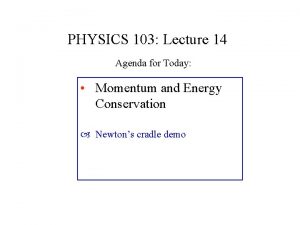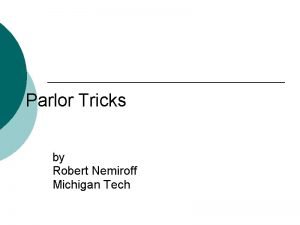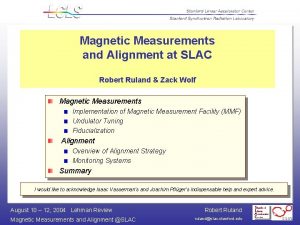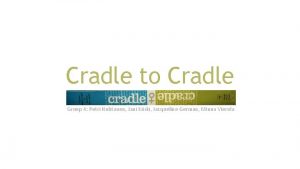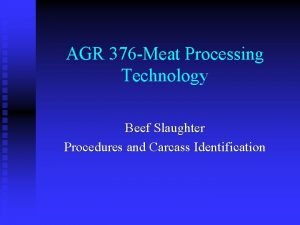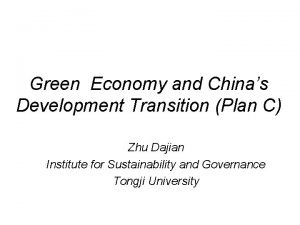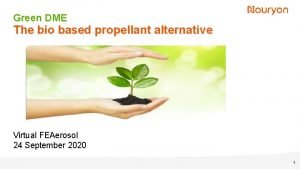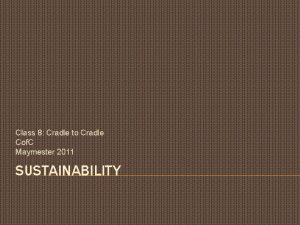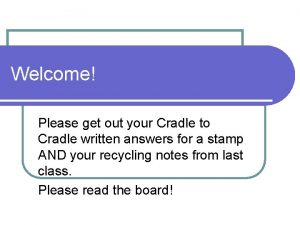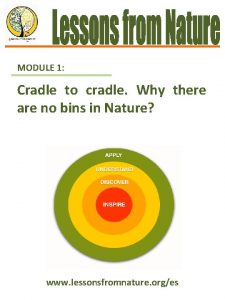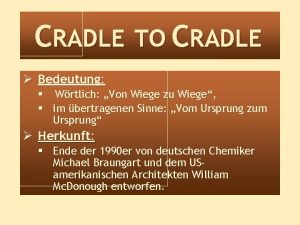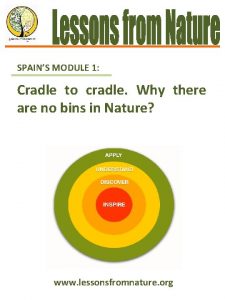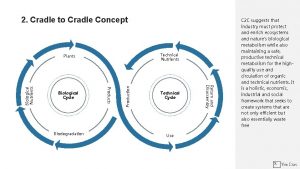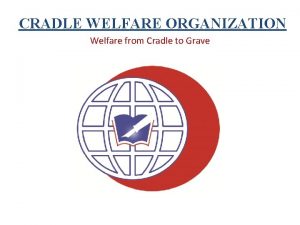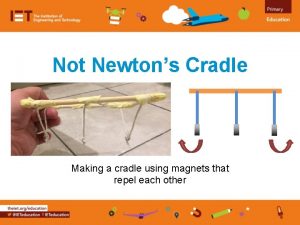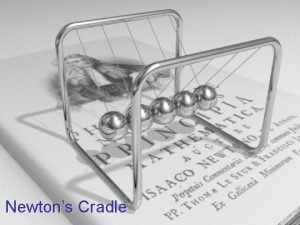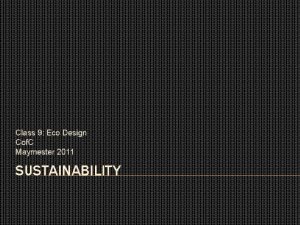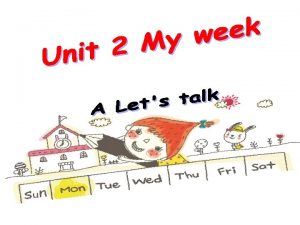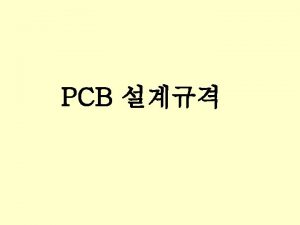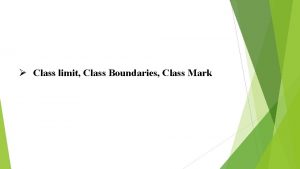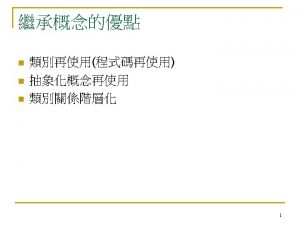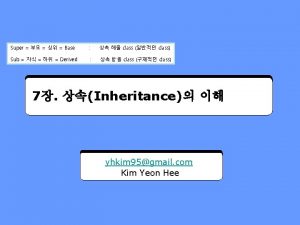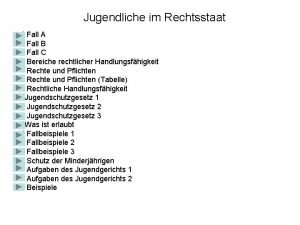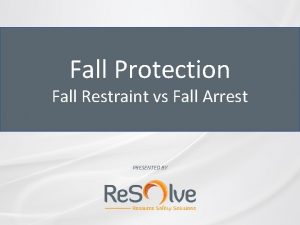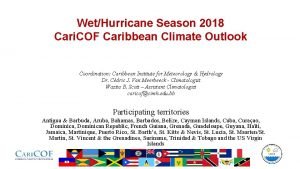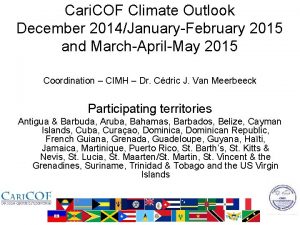Class 9 Cradle to Cradle Cof C Fall

























- Slides: 25

Class 9: Cradle to Cradle Cof. C Fall 2012 FOUNDATIONS OF SUSTAINABILITY

C 2 C PROBLEM - SOLUTION Problem: Our current ways of making things are inefficient and ineffective Why: Because they deplete resources, jeopardize our health, exploit people in developing countries, and generate massive amounts of waste. Solution: Eliminate waste , hazardous chemicals and dangerous processes in everything we make and do. How? : Re-design all products so that biological nutrients are returned to the soil and technical nutrients are returned to the “technical cycle”. Result: “Perpetually sustainable”

AUTHORS Mc. Donough = > Architect Braungart => Chemist 2002

FUNDAMENTAL QUESTIONS Composition of the book itself? Weary of “doing less bad” “Revolution is founded on nature’s surprisingly effective design principles, on human creativity and prosperity, and on respect, fair play, and goodwill. ” (p 6) Scientists trained on analysis not synthesis…lacked “vision” Need a strategy that allows “us to avoid the worst consequences of industrialism” (p 13)

INTRODUCTION Uses a familiar story about a family enjoying an evening at home reading a book, using a computer, playing with toys to set the stage and grab your attention. Turns the tables and describes the dangers built into everyday life: the computer, the carpet and fabrics, the shoes, etc. Notion of “downcycling” is current practice – not recycling. meaning that it takes energy to transform plastic bottles into carpet, which then goes to the landfill when it is worn out (remains cradle to grave)

INTRODUCTION (CONT’D) Introduces new vocabulary into the discussion: “Technical nutrients” are those parts of the things we make that cannot be returned to the soil. Good design is suited to its locale, context driven, using local materials and resources. “We see a world of abundance, not limits. In the midst of a great deal of talk about reducing the human ecological footprint, we offer a different vision. What if humans designed products and systems that celebrate an abundance of human creativity, culture and productivity? . . . [However], …Nature doesn’t have a design problem, people do” (p 16)

3 PRINCIPLES FOR THE NEXT INDUSTRIAL REVOLUTION 1. Waste equals food waste according to technical (reuse cycles or leased) or biological nutrients (compost) 2. respect diversity (design using local, cultural and material resources) - RESILIENCE 3. use solar energy (use solar “income”) rather than earth’s stored energy of

VIDEO William Mc. Donough introduces C 2 C Part 1 William Mc. Donough introduces C 2 C Part 2 William Mc. Donough introduces C 2 C Part 3 William Mc. Donough introduces C 2 C Part 4

CH 1: A QUESTION OF DESIGN “The waste, pollution, crude products, and other negative effects that we have described are not the result of corporations doing something morally wrong. They are the consequences of outdated and unintelligent design. ” p. 43

CH 2: LESS BAD IS NO GOOD Environmental History (starting with Rachel Carson’s Silent Spring) has largely been about doing “less harm” to the environment This led to a focus on “eco-efficiency” which is “doing more with less” Reduction: does not halt degradation, only slows it down “If you want to go to Mexico and are driving toward Canada, if you drive slower you eventually still end up in Canada. ” Recycling is downcycling reduces the quality of the material over time—less integrity, requires heavy chemicals, can be harmful to biosphere when processed Eco efficiency is admirable but not a long term strategy…”it only works to make the old, destructive system a bit less so. ”

CH 3: ECO-EFFECTIVENESS Introduces the concept of effectiveness over efficiency. In other words abandon the “old model of produce and waste” and “embrace the challenge of being not efficient but effective with respect to a rich mix of considerations and desires. ” p. 72 Eco-efficiency isn’t enough; need to be eco -effective as well redesign our systems

ECO-EFFECTIVENESS Econ Growth is not the problem: “The key is not to make human industries and systems smaller, as efficiency experts propound, but to design them to get bigger and better in a way that replenishes, restores, and nourishes the rest of the world” (p 78) Look to nature for redesign (e. g. cherry tree, ants, etc). “We can be humbled and by the complexity and intelligence of nature’s activity, and we can also be inspired by it to design some positive side effects to our own enterprises instead of focusing exclusively on a single end. ” (p 81)

CH 4: WASTE = FOOD

CH 4: WASTE = FOOD Blames industry for altering the natural equilibrium (p 92)…where “Throw away products have become the norm. ” (p 97) Landfills contaminate, waste or lose too many valuable nutrients (p 99)…and sewage no longer carries just human biological waste – it caries numerous hazardous chemicals that disrupt or destroy or mutate many natural cycles in our water resources and farm lands (p 101). Need to rethink the flow (of goods and waste)

CH 4: WASTE = FOOD The notion of a closed system of the Earth (mass) and sun (energy) and nothing goes in or out of the system. “Whatever is naturally here is all we have. ” Basic elements are finite and valuable…“ If our systems contaminate Earth’s biological mass and continue to throw away technical nutrients (such as metals) or render them useless, we will indeed live in a world of limits, where production and consumption are restrained, and the Earth will literally become a grave. ” If humans are to survive we will have to learn to imitate nature’s highly effective C 2 C system …” (p 103) Two metabolisms – biological and technical

CH 4: WASTE = FOOD Technical nutrients and the notion of “products of service” are introduced. pp. 109 to 115. No elegant examples of complete success at this as was the case for the wheelchair seat yet. Carpet, TV’s, automobiles are the focus of innovation in this section. Henry Fords model T with the crate as floor boards, packaging like rice husks used then t make bricks, etc. We are not there for most products for the foreseeable future. Suggest using parking lots to store unmarketable materials until ways to redesign them or new uses for them can be engineered – running shoe soles, PET, PVC, etc.

CH 4: WASTE = FOOD Definition of insanity repeated then followed by this: “Negligence has been described as doing the same thing over and over again even though you know it’s dangerous, stupid or wrong. Now that we know, it’s time for a change. Negligence starts tomorrow. ” p. 117

CH 5: RESPECT DIVERSITY Notion of fitting rather than fittest => “Fitting-est implies an energetic and material engagement with place and an interdependent relationship to it” (p 121) All sustainability is local – like politics (p 123) “By seeing sustainability as both a local and a global event, we can understand that just as it is not viable to poison local water and air with waste; it is equally unacceptable to send it downstream, or to ship it overseas to other, less regulated shores”

CH 5: RESPECT DIVERSITY Net zero does not mean isolated – off-grid. Contribute to traditional sources – eco-efficient – transitional – while new technologies and sources of generation emerge. Lots of minigenerators – more efficient “Oddly enough, professional architects seem to get by without understanding the basic principals that inspired ancient buildings and architecture orientations” (p 130)

CH 5: RESPECT DIVERSITY “eco-efficiency in service to a larger vision, not as a goal itself. ” P. 131 “Eco-effective design demands a coherent set of principles based on nature’s laws and the opportunity for constant diversity of expression. ” “What goes for aesthetics goes for needs, which vary with ecological, economic and cultural circumstances – not to mention personal preferences. ”

CH 5: RESPECT DIVERSITY Questions on page 145 for considerations: “What has worked in the past, present and what will work in the future? What kind of world do we intend and how might we design things in keeping with that vision? What will a sustainable global commerce look like 10 or even 100 years in the future? How can our products help to create and sustain it, so that future generations are enriched by what we make, not tyrannized by hazards and waste? What can we do now to begin the process of industrial re-evolution? ”

CH 5: RESPECT DIVERSITY Smith – “every man working for his own self interest will be led by an invisible hand to promote the public good. ” Free market – almost divine and highly dependent on a moral producer. Not consistent with reality Marx – everything belongs to the state – meant t address the need for equity and sharing of wealth. Capitalism often ignored the needs of the worker but communism also failed in that regard because the individual was trivialized. 16% of the former Soviet Union is unfit for habitation due to hazardous waste. P. 148

CH 5: RESPECT DIVERSITY “And there can be many of us and the things we make, because we have the right system – a creative, intelligent, prosperous and fertile system – and, like the ants we will be “effective”.

CH 6: ECO-EFFECTIVENESS INTO PRACTICE Five steps to eco-effectiveness: Get free of known culprits Follow informed personal preferences – ask manufacturers questions, tack carpet rather than glue it, etc. People do not want nor maintain ugly buildings. Create a passive positive list – list X, gray and P lists of constituents. Activate the positive list. Reinvent – start over again – circular – signal your intentions – string commitments to change for the better

CH 6: ECO-EFFECTIVENESS INTO PRACTICE Final questions posed: How can we support and perpetuate the rights of all living things to share in a world of abundance? (can be taken many ways) How can we love the children of all species – not just our own – for all time? Imagine what a world of prosperity and health would look like in the future, and begin designing for it now. What would it mean to become, once again, native to this place – Earth – the home of all our relations? This is going to take us all, and it is going to take forever. But then, that’s the point.
 Cradle to cradle design
Cradle to cradle design Cradle to grave cradle to gate
Cradle to grave cradle to gate Cradle to cradle boeken
Cradle to cradle boeken Cradle to cradle
Cradle to cradle Cof bank adalah
Cof bank adalah 3m acf 5363
3m acf 5363 The cradle of civilization
The cradle of civilization Golden cradle kindergarten
Golden cradle kindergarten Fry pan bottom pattern
Fry pan bottom pattern Comfort devices trochanter rolls
Comfort devices trochanter rolls Okonkwo family tree
Okonkwo family tree Scholarship merit badge
Scholarship merit badge Dynamics of machines
Dynamics of machines Newton's cradle drawing
Newton's cradle drawing Leg cradle to lateral lunge
Leg cradle to lateral lunge Cradle of the renaissance
Cradle of the renaissance Newton's cradle
Newton's cradle Newton's cradle tricks
Newton's cradle tricks Rizal learned the alphabet and prayers at the age of three
Rizal learned the alphabet and prayers at the age of three Cradle alignment technique
Cradle alignment technique Limburg principles
Limburg principles Pizzle eye
Pizzle eye Mesopotamia the cradle of civilization worksheet answers
Mesopotamia the cradle of civilization worksheet answers Compact city
Compact city Cradle to grave
Cradle to grave Scholarship merit badge
Scholarship merit badge
